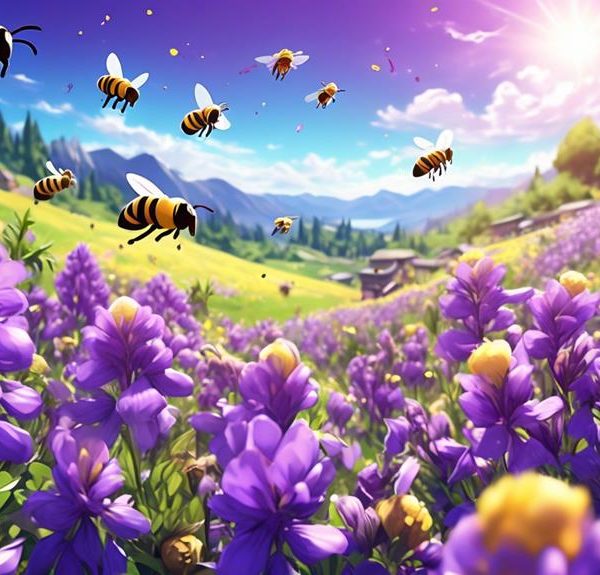Learn about the surprising relationship between bees and the Achillea plant, and how it could transform your gardening approach.
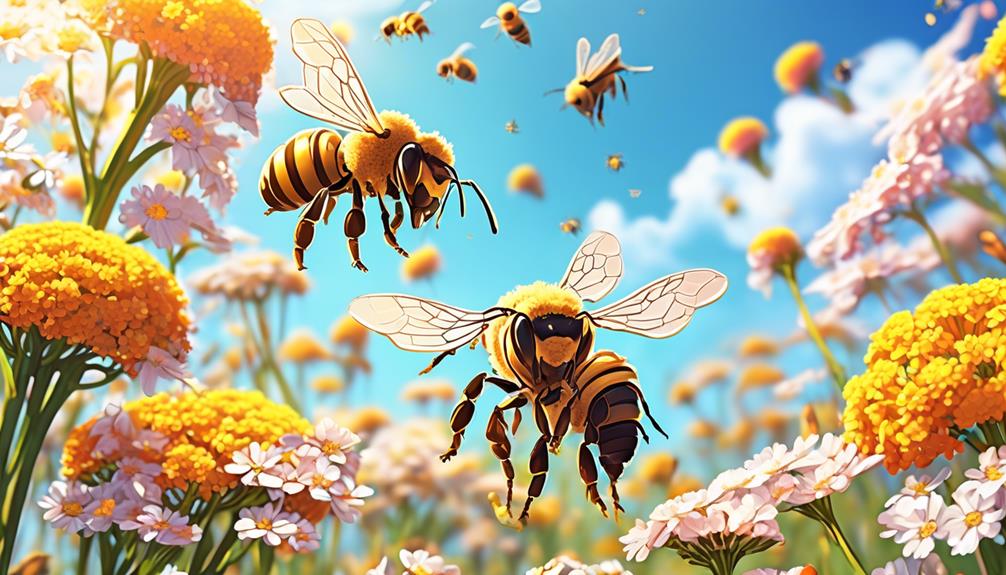
Do Bees Like Achillea?
If you've ever observed a buzzing bee, you'd think they carry the weight of the world on their tiny wings. Their ceaseless work in pollination is vital for our ecosystem, and understanding their preferences can be key to supporting their survival.
One such preference we're exploring is the Achillea plant. You might be wondering, do bees really like Achillea?
Well, as it turns out, the answer to that question may surprise you and could change the way you approach your own gardening habits.
Key Takeaways
- Bees are highly attracted to Achillea due to its bright colors, enticing aroma, rich source of nectar, and ample pollen.
- Bees play a crucial role in the pollination process of Achillea, facilitating its life cycle and seed production.
- Achillea positively impacts bee populations by providing abundant and high-quality food sources, enhancing foraging efficiency, and reducing food scarcity.
- Incorporating Achillea in your garden not only enhances its aesthetic appeal but also boosts biodiversity, plant health, and is suitable for various gardening skill levels.
Understanding the Achillea Plant
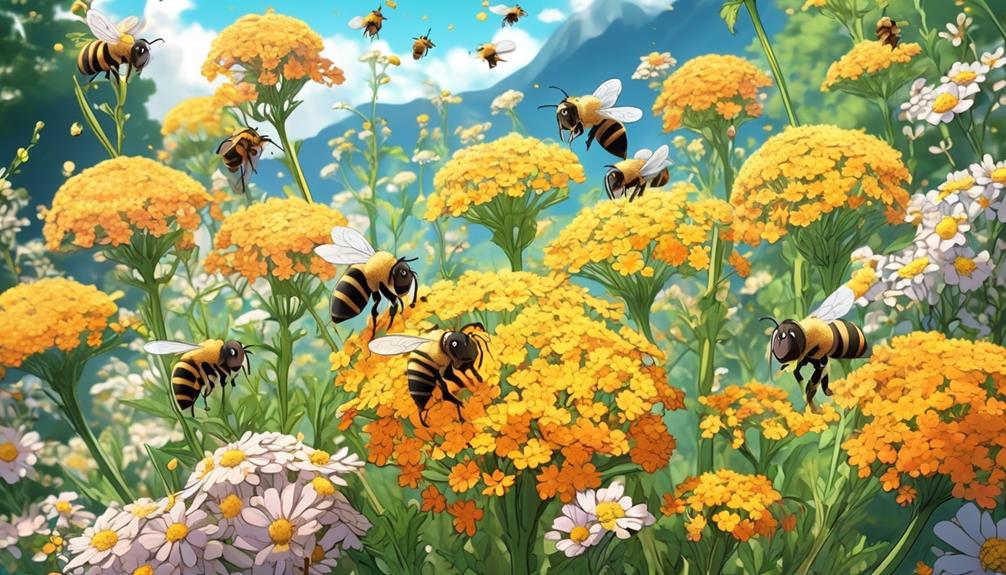
What exactly is the Achillea plant, you might be wondering? Well, let me enlighten you.
Achillea, commonly known as yarrow, is a hardy perennial herb belonging to the Asteraceae family. It's native to the Northern Hemisphere and boasts over 100 species, each with its unique characteristics.
You'll often spot Achillea plants showcasing their flat-topped clusters of small, vibrant flowers. These can range in colors from white, yellow, pink to red, blooming from early summer to late autumn. They're a sight to behold, reaching heights of up to 3 feet and spreading about 2 feet wide.
But Achillea isn't just aesthetically pleasing. It's also drought-tolerant and highly resistant to pests, making it an easy-care plant for gardeners. Its feathery, fern-like foliage emits a distinctive aroma when crushed, which some find pleasant and others less so.
Scientifically, Achillea's worth noting for its medicinal properties. For centuries, it's been used in herbal medicine for wounds, infections, and digestive issues. Its genus name, Achillea, even harks back to the Greek hero Achilles, who supposedly used the plant to heal soldiers' wounds during the Trojan War.
Bees' Attraction to Achillea

Diving into the world of bees and their interactions with Achillea, you'll quickly discover that these buzzing insects are incredibly drawn to this vibrant plant. They're not just randomly attracted, there's a symbiotic relationship between bees and Achillea.
The plant relies on bees for pollination, while the bees, in turn, feed off the nectar produced by the Achillea. It's a win-win situation, where both parties benefit.
Let's take a look at the table below to understand why bees are so attracted to Achillea:
_Characteristic_ | _Explanation_ |
|---|---|
Color | Bees are drawn to the bright colors of Achillea, especially yellow. |
Scent | Achillea releases a unique aroma that's enticing to bees. |
Nectar | The Achillea plant is a rich source of nectar, providing bees with energy. |
Pollen | Achillea has ample pollen, a source of protein for bees. |
Flower Shape | The flat, open shape of Achillea flowers makes it easy for bees to land and feed. |
Observing these interactions, it's clear that Achillea is not just a plant but a crucial lifeline for our buzzing friends. So, next time you see bees buzzing around Achillea, you'll understand the science behind their attraction.
Pollination Process With Achillea
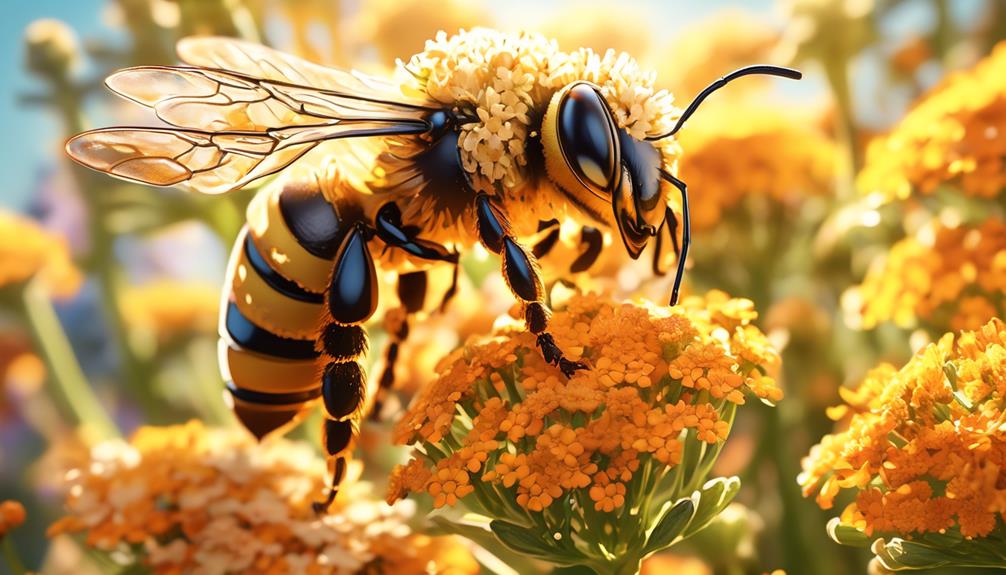
In the intricate dance of pollination, Achillea's vibrant blooms play a critical role, serving as a veritable feast for bees. As you watch, you'll see bees alight on these flower heads, their tiny feet dusted with pollen. They're not just there for a meal, but they're also unwittingly participating in a key biological process: pollination.
Achillea's composite flowers, comprised of many small florets, are rich in nectar and pollen. Bees, attracted to these resources, visit them and in the process, get covered in pollen. This pollen sticks to the bee's body and is transported to other flowers. When the bee lands on the next Achillea bloom, some of this pollen rubs off onto the flower's stigma, the receptive part of the female reproductive system.
This is where the magic happens. The pollen grains germinate, sending a tube down into the flower's ovary. Ultimately, this fertilizes the ovule, leading to the formation of a seed. So, while bees indulge in Achillea's offerings, they're also facilitating a critical part of the plant's life cycle.
Through this symbiotic relationship, both bees and Achillea thrive.
Impact of Achillea on Bee Populations
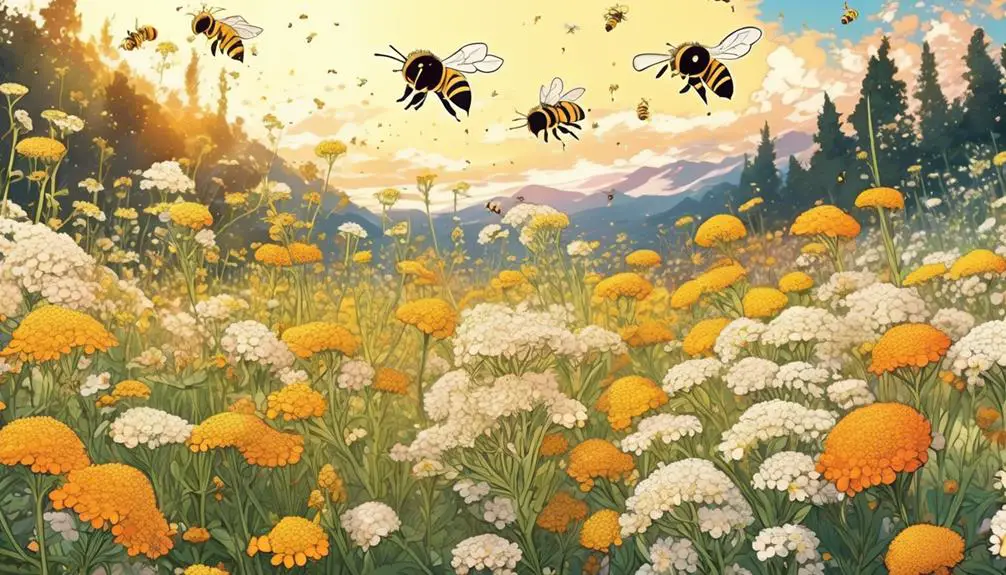
While bees are ensuring Achillea's reproduction, they're also receiving benefits that are crucial for their own survival and population growth. This mutualistic relationship between bees and Achillea not only sustains the bee populations but also enhances their vitality.
You see, Achillea, commonly known as yarrow, is a nectar-rich plant. Its clusters of tiny flowers provide an abundant food source for bees, packed with high-quality nectar and pollen. This nutritious sustenance allows bees to thrive and multiply, contributing to the overall health of their colonies.
But the perks for bees don't stop at nutrition. Achillea's vibrant colors and fragrant scent act as powerful attractants for bees. These features help increase the bees' foraging efficiency, as they're easily able to locate and return to an Achillea patch.
Furthermore, the extended blooming period of Achillea, from late spring to early fall, ensures a consistent food source for bees throughout the year. This reduces the risk of food scarcity and helps maintain stable bee populations.
In short, your observation of bees buzzing around Achillea isn't accidental. It's a display of nature's symbiosis, where Achillea plays a pivotal role in supporting bee populations. So, next time you spot a bee on Achillea, know you're witnessing a beneficial ecological interaction.
Enhancing Your Garden With Achillea

If you're looking to enrich your garden, incorporating Achillea can provide a vibrant and beneficial addition. This perennial plant, also known as Yarrow, is not just aesthetically pleasing, but it's also a magnet for pollinators like bees, enhancing your garden's overall health and productivity.
To fully appreciate its benefits, here's a table detailing Achillea's key features and their impacts on your garden.
Key Features of Achillea | Impact on Garden |
|---|---|
Vibrant Colours | Enhances aesthetic appeal |
Attracts Pollinators | Boosts biodiversity and plant health |
Drought Resistant | Ideal for dry, challenging conditions |
Low Maintenance | Suitable for both novice and expert gardeners |
Frequently Asked Questions
What Other Insects Are Attracted to Achillea Plants Besides Bees?
You're not just spotting bees on your achillea plants. Many insects find achillea irresistible.
Butterflies, for instance, are often seen fluttering around these plants, sipping nectar.
Ladybugs also frequent achillea, as they're attracted to the aphids that feed on it.
Hoverflies can't resist its allure either.
Plus, you'll notice many beneficial wasps that help control garden pests drawn to achillea.
How Can I Identify an Achillea Plant in the Wild?
Sure, identifying Achillea in the wild's easier than you'd think. Look for clumps of feathery, fern-like leaves near ground level. Above these, you'll see tall stalks topped with flat clusters of small, daisy-like flowers. These can range from white to pink or yellow. The plant often has a strong, distinctive aroma.
Can Bees Have a Negative Impact on the Growth of Achillea Plants?
No, bees don't have a negative impact on the growth of Achillea plants. In fact, it's the opposite.
Bees are vital pollinators that enhance the plant's reproduction process. As they move from flower to flower, they transfer pollen, facilitating fertilization. This ultimately results in a higher yield of seeds for the Achillea and promotes biodiversity.
What Are Some Other Plants That Bees Are Attracted to Like They Are to Achillea?
You're curious about other plants bees are drawn to, just as they're to Achillea.
Well, bees can't resist the nectar of flowering plants like lavender, sunflowers, and clover. These plants not only provide rich nectar, but their vibrant colors and fragrances act as a beacon for bees.
Are There Specific Species of Bees That Are More Attracted to Achillea Than Others?
Sure, there are specific bee species more attracted to Achillea, or Yarrow, than others. Honeybees and bumblebees are particularly keen on it. They're drawn to its flat-topped clusters of small, nectar-rich flowers.
So, if you're looking to attract these bee species, planting Achillea in your garden would be a smart move.
It's not just the bees, though. Butterflies and other beneficial insects also find Achillea irresistible.
Conclusion
So, you've seen how achillea plays a crucial role in attracting bees, aiding pollination, and boosting bee populations.
It's not just a pretty face in your garden, but a key player in maintaining a healthy ecosystem.
You're now equipped with the knowledge to enhance your garden and support our buzzing friends.
Remember, every achillea plant you add, makes a world of difference to these hard-working pollinators.


